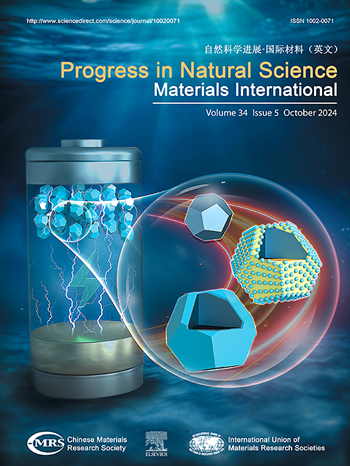设计高效被动式全天空辐射冷却的生物壳空心微粒
IF 4.8
2区 材料科学
Q2 MATERIALS SCIENCE, MULTIDISCIPLINARY
Progress in Natural Science: Materials International
Pub Date : 2024-10-01
DOI:10.1016/j.pnsc.2024.08.009
引用次数: 0
摘要
被动辐射冷却(PRC)作为最有希望满足未来冷却需求的技术,引起了人们的极大兴趣。然而,在制造适合全天使用的高效率、低成本辐射冷却器方面仍面临巨大挑战。在此,我们受非洲白甲虫 Goliathus goliatus 的启发,报告了一种基于混合法的二次微纳米壳空心结构。与均质颗粒相比,由于外壳和内部空气的反射率不同,散射光在内核(空气)和外壳(二氧化硅)界面的光路发生了变化,大部分光线从颗粒中逸出,呈现出强烈的全内反射。该设计巧妙地将纳米级壳空心结构沉积在微米级壳空心结构的表面,实现了高太阳反射率(95%)和卓越的长波红外发射率(94%)。夜间和白天可分别实现 7.8 ℃ 和 4.7 ℃ 的亚环境制冷。我们的工作为高性能被动式全天辐射制冷(PARC)的设计和制造提供了新思路。本文章由计算机程序翻译,如有差异,请以英文原文为准。
Biologically inspired shell-hollow particles for designing efficient passive all-sky radiative cooling
Passive radiation cooling (PRC), as the most promising technology to meet future cooling needs, has attracted great interest. However, there are still huge challenges in manufacturing high-efficiency and low-cost radiant coolers suitable for all-day use. Here, we report a secondary micro-nano shell-hollow structure based on blending method, inspired by the African white beetle Goliathus goliatus. Due to the difference in reflectance between the shell and the internal air, compared with the homogeneous particles, the scattered light has a changed optical path at the interface of the core (air) and the shell (SiO2), and most of the light escapes from the particles, showing strong total internal reflection. The design ingeniously deposits the nano-sized shell-hollow structure on the surface of the micron-sized shell-hollow structure, achieving high solar reflectance (95 %)and excellent long-wave infrared emissivity (94 %). Sub-ambient cooling of 7.8 and 4.7 °C can be achieved at night and daytime, respectively. Silica microspheres with shell and hollow structure can be prepared by soft template method, which is mature, reliable, simple and cheap.Our work provides new ideas for the design and manufacture of high-performance Passive all-day radiative cooling (PARC).
求助全文
通过发布文献求助,成功后即可免费获取论文全文。
去求助
来源期刊
CiteScore
8.60
自引率
2.10%
发文量
2812
审稿时长
49 days
期刊介绍:
Progress in Natural Science: Materials International provides scientists and engineers throughout the world with a central vehicle for the exchange and dissemination of basic theoretical studies and applied research of advanced materials. The emphasis is placed on original research, both analytical and experimental, which is of permanent interest to engineers and scientists, covering all aspects of new materials and technologies, such as, energy and environmental materials; advanced structural materials; advanced transportation materials, functional and electronic materials; nano-scale and amorphous materials; health and biological materials; materials modeling and simulation; materials characterization; and so on. The latest research achievements and innovative papers in basic theoretical studies and applied research of material science will be carefully selected and promptly reported. Thus, the aim of this Journal is to serve the global materials science and technology community with the latest research findings.
As a service to readers, an international bibliography of recent publications in advanced materials is published bimonthly.

 求助内容:
求助内容: 应助结果提醒方式:
应助结果提醒方式:


